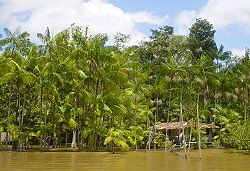What Is Acai
Açaí Palm: 
The açaí palm, or açaí, (pronounced ah-sah-ee) is one of a number
palm trees from the genus Euterpe family, which are now cultivated for
their fruit and heart of palm. The particular species which we see
marketed throughout offline and online media derives from the species
Eurterpe oleracea or Açaí Palm, after the European adaption of the
Tupian word "iwasai" - meaning "the fruit that expels or cries water".
International demand for this plant has risen dramatically since 2008
and Açaí is now cultivated primarily to meet this demand. Its sister
plant Euterpe edulis (jucara) is also used for its hearts of palm.
There are 8 species of Açaí native to South and Central America which
mainly grow in floodplains and swampy areas. Acai Palms are slender
tall trees, growing to approximately 15-35 meters, with their pinnate
leaves which house the Açaí Berry growing up to 3 meters long.
Açaí Fruit:
The Açaí fruit is a small, circular, black purple drupe generally 1
inch in width, and takes on a similar appearance to a large grape but
with less pulp. Produced within the branched pinnacles of the pinnate
leaves, the Açaí Berry grows in groups of 600-900 fruits.
The
fruit is harvested twice a year and has a single large seed
approximately 0.25-0.45 in width, with the exocarp of a ripe fruit
displaying the deep purple or lush green color, depending on type of
berry and its maturity.
The mesocarp is thin and pulpy which is
roughly 1mm which surrounds the voluminous and tough endocarp, which
houses the seed, the  diminutive embryo if you like teaming with endosperm. This seed makes up about 80% of the fruit.
diminutive embryo if you like teaming with endosperm. This seed makes up about 80% of the fruit.
The berries have been harvested as fruits for generations by 3
traditional cultures in Brazils Amazon region, where the Açaí Palm is
described as the most important species of plant in their diet as it
makes up 43% of the regions total food intake by weight and also
contains economic value for the area
It's the pulp and juice of the Açaí fruit, Euterpe oleracea - which is used in various smoothies, soda's, blends and beverages.
In north Brazil, gourds called "cuias" are the traditional way the
berry is served here, sometimes salty, sometimes sweet, or occasionally
with honey, depending on the local preference. In southern Brazil Açaí
is eaten cold, where the dish is called "Açaí na tigela" - "Açaí in a
bowl", where it's mixed with granola.
Açaí is also consumed throughout Brazil as a juice or an ice-cream, which is also sometimes used in liqueurs.


